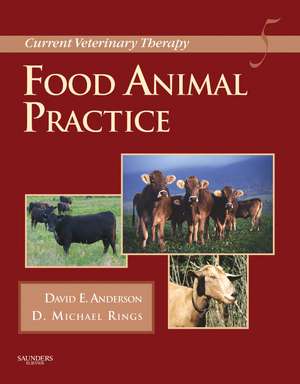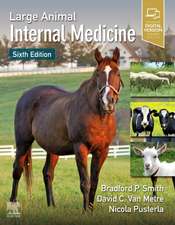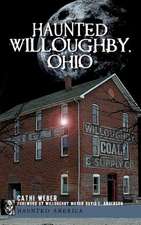Current Veterinary Therapy: Food Animal Practice: Current Veterinary Therapy
Autor David E. Anderson, Michael Ringsen Limba Engleză Hardback – 21 aug 2008
Preț: 1528.86 lei
Preț vechi: 1609.32 lei
-5% Nou
Puncte Express: 2293
Preț estimativ în valută:
292.54€ • 306.26$ • 242.06£
292.54€ • 306.26$ • 242.06£
Carte tipărită la comandă
Livrare economică 05-19 aprilie
Preluare comenzi: 021 569.72.76
Specificații
ISBN-13: 9781416035916
ISBN-10: 1416035915
Pagini: 736
Ilustrații: Approx. 300 illustrations
Dimensiuni: 216 x 276 x 33 mm
Greutate: 1.63 kg
Ediția:5
Editura: Elsevier
Seria Current Veterinary Therapy
ISBN-10: 1416035915
Pagini: 736
Ilustrații: Approx. 300 illustrations
Dimensiuni: 216 x 276 x 33 mm
Greutate: 1.63 kg
Ediția:5
Editura: Elsevier
Seria Current Veterinary Therapy
Cuprins
SECTION 1: DIGESTIVE SYSTEM
1.Pharyngeal lacerations and retropharyngeal abscesses in cattle
2.Vesicular diseases of ruminants
3.Actinomycosis and actinobacillosis
4.Esophageal obstruction (choke)
5.Bloat or ruminal tympany
6.Function and dysfunction of the ruminant forestomach
7.Simple indigestion and secondary indigestion
8.Ruminal acidosis and rumenitis
9.Rumenotomy and rumenostomy
10.Abomasal ulcers
11.Abomasal emptying defect in sheep
12.Pathophysiology of displacement of the abomasum in cattle
13.Surgical considerations for management of displacement of the abomasum in cattle
14.Prognostic indicators and comparison of corrective fixation techniques for displacement of the abomasum in dairy cattle
15.Laparoscopic abomasopexy for correction of left displaced abomasum
16.Hepatotoxicities of ruminants
17.Hemorrhagic bowel syndrome
18.Clostridium novyi (myconecrosis, black disease, and bacillary hemoglobinuria) and Clostridium septicum (braxy) infections
19.Clostridial Enterotoxemia (Clostridium perfringens)
20.Johne's disease (paratuberculosis)
21.Neonatal calf diarrhea
22.Helminth parasites of the ruminant gastrointestinal tract
23.Gastrointestinal protozoal infections in ruminants
24.Bovine viral diarrhea virus
25.Salmonellosis
26.Winter dysentery
27.Duodenal obstruction
28.Trichobezoars
29.Intussusception
30.Intestinal volvulus
31.Intestinal atresia
32.Rectal prolapse
SECTION 2: METABOLIC SYSTEM
33.Milk fever (parturient paresis) in cows, ewes, and doe goats
34.Phosphorus deficiency
35.Ruminant hypomagnesemic tetanies
36.Ketosis
37.Pregnancy toxemia of ewes
38.Fatty liver in dairy cattle
39.Clinical use of ultrasound for subcutaneous fat thickness measurements in dairy cattle
40.Metabolic profile testing in dairy cattle
SECTION 3: RESPIRATORY SYSTEM
41.Mannheimia haemolytica- and Pasteurella multocida-induced bovine pneumonia
42.Bovine respiratory disease virology
43.Mycoplasmas in bovine respiratory disease
44.Sheep and goat respiratory disease
45.Diseases of the upper respiratory system in cattle, sheep, and goats
46.Surgery of the upper respiratory tract
47.Surgery of the thorax
SECTION 4: CARDIOVASCULAR SYSTEM
48.Examination of the bovine patient with heart disease
49.Congenital heart disease in cattle
50.Acquired heart diseases in cattle
SECTION 5: MUSCULOSKELETAL SYSTEM
51.Noninfectious disorders of the foot
52.Infectious disorders of the foot skin
53.Surgery of the bovine digit
54.Small ruminant infectious disease of the foot
55.Fracture management in cattle
56.Septic arthritis in cattle
57.Osteochondrosis in cattle
58.Ligament injuries of the stifle
59.Coxofemoral luxation
60.Hygroma of the carpus and tarsus
SECTION 6: NEUROLOGICAL SYSTEM
61.Clinical examination
62.Ancillary tests
63.Muscular tone and gait abnormalities
64.Cranial nerve abnormalities
65.Mentation abnormality, depression, and cortical blindness
66.Central nervous system infection and infestation
SECTION 7: URINARY SYSTEM
67.Urolithiasis
68.Urinary tract infection in food animals
69.Neonatal urinary disorders
70.Ulcerative posthitis
71.Bovine enzootic hematuria
72.Surgery of the urinary tract
SECTION 8: GENITAL SURGERY - MALE
73.Diagnosis and management of juvenile anomalies of the penis and prepuce
74.Diagnosis and management of penile deviations
75.Diagnosis and management of injuries to the penis and prepuce of bulls
76.Diagnosis and management of inguinal hernia in bulls
77.Diagnosis and management of conditions of the scrotum and testes
78.Preparation of teaser bulls, rams, and bucks
SECTION 9: GENITAL SURGERY - FEMALE
79.Bovine cesarean sections: risk factors and outcomes
80.Surgery of the vagina and nongravid uterus
81.Umbilical surgery in calves
82.Diagnosis and management of teat injury
83.Laparoscopy in large animal surgery
SECTION 10: OPHTHALMOLOGY
84.Ophthalmic examination techniques for production animals
85.Selected eye diseases of cattle
86.Selected eye diseases of sheep and goats
87.Ophthalmology of South American camelids: llamas, alpacas, guanacos, and vicunas
88.Selected eye diseases of swine
89.Food animal ocular neoplasia
90.Neurogenic vision loss
91.Ophthalmic therapeutics
92.Enucleation in the bovine
SECTION 11: PHARMACOLOGY AND THERAPEUTICS
93.Ethical responsibilities of bovine veterinarians in selecting and using therapeutic drugs
94.Ethical responsibilities of small ruminant veterinarians in selecting and using therapeutics
95.Practical pharmacokinetics for the food animal practitioner
96.The Food Animal Residue Avoidance Databank (FARAD) and related drug regulations
97.Anthelmintic therapy in an era of resistance
98.Antimicrobial resistance in human pathogens and the use of antimicrobials in food animals: challenges in food animal veterinary practice
99.Evidence-based veterinary medicine - therapeutic considerations
100.Therapeutic options in organic livestock medicine
101.Decision making in mastitis therapy
102.Respiratory disease treatment considerations in feedyards
103.Antibiotic treatment of diarrhea in preweaned calves
104.Fluid therapy, transfusion, and shock therapy
105.Pain management in cattle and small ruminants
SECTION 12: CHEMICAL RESTRAINT, GENERAL ANESTHESIA, AND PAIN MANAGEMENT
106.Chemical restraint in ruminants
107.General anesthesia in ruminants
108.Managing severe pain in ruminants
SECTION 13: COW-CALF/SMALL RUMINANT PRODUCTION MEDICINE
109.Marketing beef cow-calf production medicine in private practice
110.Economic analysis techniques for the cow-calf practitioner
111.Cow-calf operation beef quality assurance (BQA)
112.Biosecurity for cow-calf enterprises
113.Management of neonatal diarrhea in cow-calf herds
114.Calf preweaning immunity and impact on vaccine schedules
115.Beef heifer development
116.Investigation and abortion and fetal loss in the beef herd
117.Addressing high dystocia incidence in cow-calf herds
118.Carcass ultrasound uses in beef cattle production settings
SECTION 14: FEEDLOT PRODUCTION MEDICINE
119.Preconditioned calves in the feedyard
120.Low stress livestock handling
121.Biosecurity for feedlot enterprises
122.Use of statistical process control in feedlot practice
123.Growth promotants
124.Feedlot vaccination protocols
125.An economic risk assessment model for management of pregnant feeder heifers
126.Investigation of lameness outbreaks in feedlot cattle
127.Investigating a respiratory disease outbreak
128.Feedlot therapeutic protocols
129.Managing hospital pen systems
130.No loose parts necropsy procedure for the feedyard
1.Pharyngeal lacerations and retropharyngeal abscesses in cattle
2.Vesicular diseases of ruminants
3.Actinomycosis and actinobacillosis
4.Esophageal obstruction (choke)
5.Bloat or ruminal tympany
6.Function and dysfunction of the ruminant forestomach
7.Simple indigestion and secondary indigestion
8.Ruminal acidosis and rumenitis
9.Rumenotomy and rumenostomy
10.Abomasal ulcers
11.Abomasal emptying defect in sheep
12.Pathophysiology of displacement of the abomasum in cattle
13.Surgical considerations for management of displacement of the abomasum in cattle
14.Prognostic indicators and comparison of corrective fixation techniques for displacement of the abomasum in dairy cattle
15.Laparoscopic abomasopexy for correction of left displaced abomasum
16.Hepatotoxicities of ruminants
17.Hemorrhagic bowel syndrome
18.Clostridium novyi (myconecrosis, black disease, and bacillary hemoglobinuria) and Clostridium septicum (braxy) infections
19.Clostridial Enterotoxemia (Clostridium perfringens)
20.Johne's disease (paratuberculosis)
21.Neonatal calf diarrhea
22.Helminth parasites of the ruminant gastrointestinal tract
23.Gastrointestinal protozoal infections in ruminants
24.Bovine viral diarrhea virus
25.Salmonellosis
26.Winter dysentery
27.Duodenal obstruction
28.Trichobezoars
29.Intussusception
30.Intestinal volvulus
31.Intestinal atresia
32.Rectal prolapse
SECTION 2: METABOLIC SYSTEM
33.Milk fever (parturient paresis) in cows, ewes, and doe goats
34.Phosphorus deficiency
35.Ruminant hypomagnesemic tetanies
36.Ketosis
37.Pregnancy toxemia of ewes
38.Fatty liver in dairy cattle
39.Clinical use of ultrasound for subcutaneous fat thickness measurements in dairy cattle
40.Metabolic profile testing in dairy cattle
SECTION 3: RESPIRATORY SYSTEM
41.Mannheimia haemolytica- and Pasteurella multocida-induced bovine pneumonia
42.Bovine respiratory disease virology
43.Mycoplasmas in bovine respiratory disease
44.Sheep and goat respiratory disease
45.Diseases of the upper respiratory system in cattle, sheep, and goats
46.Surgery of the upper respiratory tract
47.Surgery of the thorax
SECTION 4: CARDIOVASCULAR SYSTEM
48.Examination of the bovine patient with heart disease
49.Congenital heart disease in cattle
50.Acquired heart diseases in cattle
SECTION 5: MUSCULOSKELETAL SYSTEM
51.Noninfectious disorders of the foot
52.Infectious disorders of the foot skin
53.Surgery of the bovine digit
54.Small ruminant infectious disease of the foot
55.Fracture management in cattle
56.Septic arthritis in cattle
57.Osteochondrosis in cattle
58.Ligament injuries of the stifle
59.Coxofemoral luxation
60.Hygroma of the carpus and tarsus
SECTION 6: NEUROLOGICAL SYSTEM
61.Clinical examination
62.Ancillary tests
63.Muscular tone and gait abnormalities
64.Cranial nerve abnormalities
65.Mentation abnormality, depression, and cortical blindness
66.Central nervous system infection and infestation
SECTION 7: URINARY SYSTEM
67.Urolithiasis
68.Urinary tract infection in food animals
69.Neonatal urinary disorders
70.Ulcerative posthitis
71.Bovine enzootic hematuria
72.Surgery of the urinary tract
SECTION 8: GENITAL SURGERY - MALE
73.Diagnosis and management of juvenile anomalies of the penis and prepuce
74.Diagnosis and management of penile deviations
75.Diagnosis and management of injuries to the penis and prepuce of bulls
76.Diagnosis and management of inguinal hernia in bulls
77.Diagnosis and management of conditions of the scrotum and testes
78.Preparation of teaser bulls, rams, and bucks
SECTION 9: GENITAL SURGERY - FEMALE
79.Bovine cesarean sections: risk factors and outcomes
80.Surgery of the vagina and nongravid uterus
81.Umbilical surgery in calves
82.Diagnosis and management of teat injury
83.Laparoscopy in large animal surgery
SECTION 10: OPHTHALMOLOGY
84.Ophthalmic examination techniques for production animals
85.Selected eye diseases of cattle
86.Selected eye diseases of sheep and goats
87.Ophthalmology of South American camelids: llamas, alpacas, guanacos, and vicunas
88.Selected eye diseases of swine
89.Food animal ocular neoplasia
90.Neurogenic vision loss
91.Ophthalmic therapeutics
92.Enucleation in the bovine
SECTION 11: PHARMACOLOGY AND THERAPEUTICS
93.Ethical responsibilities of bovine veterinarians in selecting and using therapeutic drugs
94.Ethical responsibilities of small ruminant veterinarians in selecting and using therapeutics
95.Practical pharmacokinetics for the food animal practitioner
96.The Food Animal Residue Avoidance Databank (FARAD) and related drug regulations
97.Anthelmintic therapy in an era of resistance
98.Antimicrobial resistance in human pathogens and the use of antimicrobials in food animals: challenges in food animal veterinary practice
99.Evidence-based veterinary medicine - therapeutic considerations
100.Therapeutic options in organic livestock medicine
101.Decision making in mastitis therapy
102.Respiratory disease treatment considerations in feedyards
103.Antibiotic treatment of diarrhea in preweaned calves
104.Fluid therapy, transfusion, and shock therapy
105.Pain management in cattle and small ruminants
SECTION 12: CHEMICAL RESTRAINT, GENERAL ANESTHESIA, AND PAIN MANAGEMENT
106.Chemical restraint in ruminants
107.General anesthesia in ruminants
108.Managing severe pain in ruminants
SECTION 13: COW-CALF/SMALL RUMINANT PRODUCTION MEDICINE
109.Marketing beef cow-calf production medicine in private practice
110.Economic analysis techniques for the cow-calf practitioner
111.Cow-calf operation beef quality assurance (BQA)
112.Biosecurity for cow-calf enterprises
113.Management of neonatal diarrhea in cow-calf herds
114.Calf preweaning immunity and impact on vaccine schedules
115.Beef heifer development
116.Investigation and abortion and fetal loss in the beef herd
117.Addressing high dystocia incidence in cow-calf herds
118.Carcass ultrasound uses in beef cattle production settings
SECTION 14: FEEDLOT PRODUCTION MEDICINE
119.Preconditioned calves in the feedyard
120.Low stress livestock handling
121.Biosecurity for feedlot enterprises
122.Use of statistical process control in feedlot practice
123.Growth promotants
124.Feedlot vaccination protocols
125.An economic risk assessment model for management of pregnant feeder heifers
126.Investigation of lameness outbreaks in feedlot cattle
127.Investigating a respiratory disease outbreak
128.Feedlot therapeutic protocols
129.Managing hospital pen systems
130.No loose parts necropsy procedure for the feedyard









